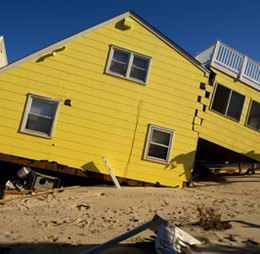
The Jersey Shore picks up the pieces after Hurricane Sandy
Three weeks had passed, but the 80-year-old floorboards were still damp. Their Brigantine home stripped of carpets, drywall, and any resemblance of their 15 years of memories, Lynn and Bob Mauger looked at what was their kitchen and where they planned to host this year’s Thanksgiving dinner.
Instead, the holiday would be spent at a nearby apartment rented for her daughter and son-in-law—a Brigantine police officer—by FEMA.
Around the corner from their East Beach Avenue home, just a block from the storm-surge pounded seawall, the Peltonen family scrolled through surreal photos including a lifeguard station, where their son spends his summers, tossed effortlessly on its side in the middle of East Brigantine Avenue.
Jane and Augie Peltonen have lived on 11th Street North for 19 years and never before had a drop of water in their three-story home. Feeling safe enough to stay behind in their high refuge, they watched on Oct. 29 as the flood waters turned their road into a river and water began to breach their lower floor, rising at least 18 inches—and much higher outside—before receding and destroying everything in its path.
When the dank smell became too much a few days later, Jane didn’t wait for the stores to open back up to buy a box cutter. As President Barack Obama visited with residents just a few blocks away at the North Point Marina, she was busy tearing away at the carpets with everyday kitchen knives.
Further north in Long Beach Island, an even more unapologetic wrath was faced, where in the quiet community of Holgate, several homes were wiped off their foundations, leaving nothing to do but start over.
In Beach Haven, Bob Spiegle sat in an old dining room chair in the garage of what was his childhood summer home, recalling how craftily he used to be able to sneak out at 5 o’clock in the morning at just 13 years old, though his parents slept just above the metal garage door.
He would grab his surfboard—Spiegle was a surfer, known as one of the first on LBI in the ’60s—and head out to the beach in front of their Leeward Avenue home. Now, surrounded by the devastation left in the wake of Superstorm Sandy—the front of their home blown open, sand covering everything in sight, and the pilings and underbellies of everyone’s homes exposed—he couldn’t help but enjoy the memories and laugh for just a moment.
With their home being just a few blocks from Holgate, it could have been worse, he admitted; it could have been worse.
Resorts turned into war zones
The smell of mildew was gone from the air, but piles of belongings on the island’s curbs remained, growing taller the further south you went even weeks after the storm as the cleanup efforts relentlessly continued. Island police and the National Guard remained on patrol, blocking unnecessary travel to Holgate and enforcing a 4 p.m. curfew for residents to get out. Much of what was left behind was uninhabitable.
“You just gotta look at this and say, I can’t save this, it’s gone, move on,” says Spiegle, who’s now living in Tennessee but came home to help dig his 85-year-old mother’s home out. The damage would have been more catastrophic if it weren’t for the bulkhead built by his father after the nor’easter of 1962—dubbed the Ash Wednesday Storm—which destroyed some 45,000 homes on Jersey’s vulnerable coast. Only part of the Spiegle home will likely have to be torn down from Sandy.
“I think in some ways it was as bad, this storm, but in some ways, it wasn’t,” says Spiegle, who was 12 at the time.
But his mother, living without heat or hot water until Dec. 1 at the earliest, disagrees without hesitation. “No, this one was worse than ’62,” says 85-year-old Doris. “They were kids at the time. As an adult then and now looking back at it, this one was definitely worse.”
In the tight-knit communities along South Jersey’s coast, where many families have lived for enough decades to be able to compare the two first-hand, most are in agreement. The Ash Wednesday Storm was indeed the storm of the century—but it was a different century and nature is a new beast.
This time around, more than two million lost power for days, some weeks, and preliminary aerial estimates by federal officials show a staggering 72,000 homes and businesses are battered in the Garden State, many completely devastated. Add to that the death toll, which is at least 37.
“I’ve been doing public service for 30 years, and we had no point of reference for this storm,” says Brigantine Fire Chief Jim Holl. “We topped the 1962 storm by about a foot. … For this municipality, the storm was unprecedented.”
Borrowing skiffs from the Brigantine Rowing Club, the fire department lost count after 107 rescues during the storm. “They were rescuing people faster than we could document it,” he says, adding fires were also breaking out, including one on Lafayette Boulevard where they lost one of their trucks to the floodwaters. A resident, witnessing the firefighters abandon their vehicle and wade through the water, likened it to a scene out of a Vietnam War movie, where soldiers were chest deep in water with their guns over their head; only these were first responders, their weapons fire hoses.
These actions were the department’s “finest hour,” Holl says, adding they responded to 239 alarms in the eight-day period that began Oct. 28, the day before landfall. “Needless to say, more citizens should have listened to the warnings and evacuated that day. With the rise of the first tide, people realized that they had made a serious error in judgment.”
One call included the care, and unsuccessful resuscitation, of a 73-year-old with hypothermia whose home had flooded. His family left the island, but he was known as an unyielding man who wanted to protect his home. His was one of the few South Jersey casualties linked to the hurricane, which led to more than 175 deaths from the Caribbean to Canada and an estimated $78 billion and rising in property damage, including $36.8 billion in New Jersey alone. It will be some time before definitive figures are determined, but it’s without doubt one of the most destructive weather events to ever hit the Northeast.
Already, more than 317,000 have registered for FEMA assistance across the Northeast, with more than $300,000 million in aid being approved—a figure that rises with each passing day. In mid-November, the federal agency began bringing in manufactured homes for those displaced in the hardest hit areas further north.
“I’ve been here my whole life,” says Mike Bagnell, mayor of Ventnor, “and I was young during the March storm of 1962, and this water got eight to 10 inches higher. That was the gauge that everyone used to use as the highest tide you could get here, but this surpassed that storm. It was something that we couldn’t plan for.”
At the Ventnor City Fire Department, the power and even backup generators failed at the height of the storm. Communications were maintained thanks to backup radios, but eventually the water was too high for their own vehicles to leave the building for the numerous vehicle and house fire calls. They used dump trucks from the public works department instead. For lack of a better term, Chief John Hazlett says it looked like Armageddon. “Everything was black and the floodwaters were waste deep,” he says. “The magnitude of this storm was something we’ve never seen before.”
Though homes weren’t destroyed like elsewhere, evacuation orders remained in effect longer than some barrier island towns, until Nov. 2, because of problems with the sewage system. “Technically, half of our city became part of the bay for about five hours,” Bagnell says. “From one foot to five feet of our city was underwater, and that got through the manholes and the curb vents and basement floor system and it overwhelmed our sewage system.”
Calls to the fire department only increased when residents returned due to electrical fires and gas leaks when power was restored, but Hazlett says the city is on the road to normalcy.
Residents have thrown out damaged belongings, opened up their home’s walls, and are replacing corroded electric, the mayor says, and the city will return to business as usual. “It’s one of those things that you have to pick yourself up and move on. Mother Nature is going to do what she does; we can’t stop her.”
And, as many point out, nature has become only more unpredictable. Augie Peltonen says when he first moved to Brigantine in 1993, he was told they didn’t have to worry about hurricanes because of Cape Hatteras in North Carolina, which acts as a self-sacrificing buffer and pushes storms out to sea like a pinball machine. But this time, high tide, a full moon, and a low-pressure system came together to suck the category 1 storm inward for a direct hit.
“You hear about many storms being called the storm of the century,” says Rob Cozen, deputy coordinator of the Office of Emergency Management in Somers Point. “What we are learning is that none of the previous predictions are valid. We are in a period of completely unstable weather.”
The lucky ones
While no town was necessarily spared completely, residents where the water came and went without taking material possessions with it knew they were fortunate. “The recovery period for us wasn’t that critical,” says Cozen. “Some houses had to be red tagged because of flooding, we had some infrastructure issues with power and sewage, and our beaches got eroded, but we got off relatively easily.”
Even in a town like Avalon, where public information officer Scott Wahl says the ocean met the door handles in the downtown business district, there are silver linings. “Avalon is still open for business,” he says proudly, adding it’s because of the cleanup efforts and everyone coming together to restore the town.
A group of volunteers even paid out of their own pockets to help out at a shelter set up at Cumberland Regional High School more than an hour away. “Despite Avalon not being hit so hard, the citizens still were going out of their way to help in any way they could.”
People also came from as far away as Maryland, in response to a Facebook message, to help clean up the grounds of Lucy the Elephant in Margate, which stands as a symbol of Jersey’s strength and resilience. About $70,000 worth of damage was sustained, mostly to the grounds itself, but the popular attraction is back open thanks to volunteers. They’re now selling “Still Standing” T-shirts as a fundraiser for hurricane victims across the state.
“Lucy was very fortunate to have come through it virtually unscathed,” says CEO Rich Helfant. “Donating a portion of the proceeds from the T-shirt is our way of giving back to our community.”
Deputy Fire Chief Dan Adams reaffirms that Margate is in good shape overall. “Our public works department is out there every day; 90 percent of the sand is gone,” he says. “It’s amazing how they [public works] brought the city back together.”
The island community is a good example of fortitude. When city hall was overwhelmed with water, operations were moved to the vacant Union Avenue School, allowing the city to be up and running by the Friday following the storm, in plenty of time for people to vote in the next Tuesday’s election.
“We were able to spring into action immediately after the storm ended. In terms of the rest of town, from the public’s standpoint, there was some damage, but it was not catastrophic,” says City Clerk Thomas Hiltner, who’s working out of the old nurse’s office in the elementary school, though adding “not catastrophic” still led to an estimated $60 million in damages. “Our biggest cleanup efforts were primarily about three million cubic feet of sand that washed up on the city streets that had to be cleaned up and moved back to the beach.”
Dunes have to be rebuilt all along the coast, where the average New Jersey beach is now 30-40 feet shorter, with some spots losing up to 150 feet, according to Stockton College’s Coastal Research Center.
These dunes, both criticized and revered by many, are said to have saved many towns, including Stone Harbor and Avalon, where a major beach fill project—involving more than 140,000 cubic yards of sand being placed on the north end beaches—was announced just before Sandy’s strike as a response to last year’s Irene damage.
The U.S. Army Corps of Engineers has pumped $700 million into beach replenishment in New Jersey since 1986 to help protect the state’s $35 billion tourism industry.
“Most of the damage here was to our beach area,” says Louis M. Blasco, city administrator for North Wildwood. “The dunes were breached in a couple of areas, but that’s what they were built for.”
North Wildwood undertook a major beach replenishment program in 2009 and constructed a system with a 14-foot dune that runs the entire beach. “Left to nature, we wouldn’t have faired as well,” Blasco says. “While [the construction] was in progress, we received complaints about the height of the dune because it was taller and people had to walk over it, and in some cases it might have taken the view away from a property owner. But ultimately, it served its purpose.”
Across the Wildwood region, residents were relatively unscathed. They were fortunate enough to be able to help those who were more greatly affected, even hosting a wedding for a displaced bride and groom that following Saturday at the Wildwoods Convention Center.
“I know there are people and businesses in North Wildwood that are not yet reopened and having to remove and reinstall carpeting before opening back up,” says John Siciliano, executive director of the Greater Wildwoods Tourism Improvement and Development Authority. “But it’s better to say ‘I’m waiting for new carpet,’ than ‘I’m waiting for a new building.’”
He added that sometimes he hears people comment, perhaps complain, about the width of the beaches. “Guess what: It took every foot of that 2,300 feet [from the boardwalk down to the waterline], and that’s what saved damage from the boardwalk. Even Sandy got tired.”
As Blasco recognizes, they may have had flooding, “but compared to what happened up north, we mostly have a cleanup effort underway instead of a rebuilding effort.”
What now?
Back on Long Beach Island, Harvey Cedars was another town spared from major damage and flooding thanks to its dune system, though it’s separated from Holgate by just 13 miles. It’s where Medford’s Phil Kunz owns a 1939 bayfront home, near where his parents owned a summer place since 1969.
When he was able to get back on the island, he was stopped three times by police checking to see that he was a local. Kunz, the president of the Harvey Cedars Taxpayers Association, then rode his bicycle around town shooting video to share with residents who couldn’t come back yet and wanted to know how their property faired. “It was nerve-wracking [for everyone],” Kunz says. “After the fact, it was even tougher. Everyone was anxious; how bad was it?”
From the north side at Barnegat Light, where no oceanside home flooding was reported, it got progressively worse down the 18-mile stretch of land. He hasn’t made it to the south end just yet. He doesn’t want to get in the way.
“We were lucky there were no deaths on the island,” Kunz says. “This is a sure-fire sign; you are better off leaving, secure what you can and hope it’s there when you come back. It’s only property—not your life.”
It’s a mantra shared by Brigantine’s Jane Peltonen. “I find that the loss of stuff doesn’t bother me at all,” she says, shortly after loading five large storage containers with the help of about 40 spontaneous volunteers who were walking the streets, some from Stockton College and others from unaffected areas around town organized by the Brigantine Community Center.
The community center, like those in many other towns, has served as a haven for many. “After four days without heat or a shower, I went to the community center,” Peltonen says. “They gave me a cup of tomato soup. I felt like a refugee, but it was so wonderful. It was like the tipping point; OK, there’s hope. … and it’s been gradually getting better.”
While looking at more photos of their street during the storm, including one shot just before her husband had to drive his truck over neighbors’ lawns to get it to higher ground, she points out the plastic being used on their spiral staircase to seal off the first floor, where nearly everything but the kitchen in their downstairs rental had been torn out. That was to come next.
It’ll be several weeks, perhaps months, before her home returns to normal, and longer for some towns, but she finds comfort in looking forward to summer, saying Brigantine and Jersey are both strong and, besides, “summer at the Shore is healing no matter what.”
Adds Kunz: “This expands what the Shore is to you. You’ve seen it wrecked and now you’ll see it beautiful again. … As a police chief said to me, ‘We’ll be sitting on the beach in June.’”
What will be surrounding the beach, however, remains to be seen. —
Want to Help?
Thousands of New Jersey residents are still displaced or in need, but you can help them return some sense of normalcy to their lives, even if it’s small. There are a multitude of events going on in South Jersey, giving people the opportunity to donate their time, money or supplies. This is just a sampling of them; if there’s anything we’ve missed, email information to Colleen@SouthJersey.com and we’ll promote it on our Facebook page.
A bowling fundraiser, Strikes for Sandy, will be held at Glassboro Bowl & Recreation Center, 503 Delsea Drive N., on Dec. 7. The cost is $15, which goes from 3-5:30 p.m. For more, call (856) 273-1282.
Student organizations at the Gloucester Township campus of Camden County Technical Schools are collecting food, water, jackets and more; FFA students are selling floral arrangements to raise money; and a blood drive will be held in the conference center at 343 Berlin Cross Keys Road, Sicklerville, on Dec. 7 from 8 a.m. to 2 p.m. For more, contact the school at (856) 767-7000.
Local bands have come together for Exit 4 for the Jersey Shore – A Hurricane Sandy Relief Concert to be held Dec. 8, 4-9 p.m. at Top Dog, 2310 Route 70, Cherry Hill. All proceeds from the $20 entry fee will go to the Hurricane Sandy New Jersey Relief Fund. For more information on the relief fund or to donate directly, visit SandyNJReliefFund.org.
Santa’s Sandy Hands is collected unwrapped new toys for the children affected until Dec. 10. For more information and a list of drop-off locations, visit OceanHappening.com/Santas-Sandy-Hands.
New Jersey’s Sixth and Eighth District legislative offices are collecting nonperishable food as well as toiletry items, baby food and diapers, and clothing. All donations can be dropped between 9 a.m. and 5 p.m. Monday through Friday at 1309 Route 70 W., Suite A, Cherry Hill; 1101 Laurel Oak Road, Suite 150, Voorhees; or 176 Route 70, Medford. For more, call (856) 429-1572, (856) 435-1247 or (609) 654-1498.
ShoreHelpers.com launched as an online portal connecting families and businesses affected with people who can help. There are currently 921 volunteers who have registered on the website to offer their help, as well as dozens of requests including anything from someone needing help transporting their displaced pets from a shelter to their new, temporary apartment to tearing out drywall and hauling away debris.
Help After the Hurricane
A Special Advertising Section from the pages of South Jersey Magazine
Whether renovating or rebuilding, these professionals can help you get back to normal.
Eric’s Nursery & Garden Center
Eric’s Nursery and Garden Center is a full-service design/build organization with certified landscape architects and designers who have served the Jersey Shore for many years. Their expert staff is ready to help you return your property to its pre-storm beauty.
Mount Laurel
(856) 231-0444
EricsNursery.com
Glassboro Lumber & Kitchens, Inc.
As a family-owned and operated business, they are here to help you and your family rebuild your home by supplying the highest quality building products and personalized customer service.
Glassboro
(856) 881-9124
GlassboroLumber.com
Under Construction Builders, LLC
For decades, they have lived, worked and built homes at the Shore and in South Jersey. They can help you.
Cherry Hill
(856) 354-0831
UCBuildersNJ.com
Young’s Landscape Management / Y-Turf Division
As homeowners look to recover from Hurricane Sandy, Young’s Y-Turf division offers a cost-effective and highly durable landscaping solution. Whether for a summer home or primary residence, synthetic turf is lush, vibrant and lifelike with a fresh-cut appearance year-round—a nice complement for natural plantings and hardscaping. The virtually maintenance free alternative is great for small or overly shaded areas and an ideal replacement for traditional stones or sand at many Shore homes.
Serving Delaware Valley to the Jersey Shore
(609) 654-5247
YTurf.com
Photo ©2012 Jim Graham / GSI
Published (and copyrighted) in South Jersey Magazine, Volume 9, Issue 9 (December, 2012).
For more info on South Jersey Magazine, click here.
To subscribe to South Jersey Magazine, click here.
To advertise in South Jersey Magazine, click here.












